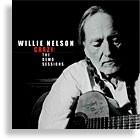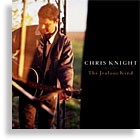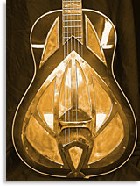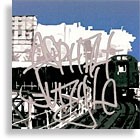The album starts off with “Detroit Rock City,” and includes other covers, like the Who’s “Pinball Wizard” and two Scorpions tunes, among others. The final track is a version of Black Sabbath’s “War Pigs” that clocks in at 10:33.
A heavy metal tribute album? Well, sort of … but don’t expect a lot of power chords and a decibel level in the triple-digit range.
The Alex Skolnick Trio’s Goodbye to Romance: Standards For A New Generation (yep, the title track is a cover of an Ozzy Osbourne tune) proffers the aforementioned songs and more in a jazz format, with the instrumentation consisting of a hollowbody electric guitar, upright bass, and drums.
Adding to the irony is the fact that Alex Skolnick is the former lead guitarist for Testament, a thrash-metal band that was compared to the likes of Anthrax or early Metallica. In a recent conversation, Skolnick discussed his musical history and instruments, including his 180-degree turn regarding his guitar playing. He is originally from Berkley, California, and his upbringing in the musically active Bay Area prompted our first inquiry:
Vintage Guitar: You probably didn’t come of age listening to guitarists like Joe Pass, Wes Montgomery, or Kenny Burrell…
Alex Skolnick: (chuckles) No, I came of age listening to Randy Rhoads, Eddie Van Halen, Michael Schenker, and Jimi Hendrix. I read interviews with some of those guys, and they talked about guitarists like Leslie West, Jeff Beck, and Eric Clapton. It was through Beck and some of the musicians he played with that I discovered John McLaughlin, and McLaughlin would often talk about Miles Davis. That’s where I started getting into jazz – a trumpet player who spanned many decades and different styles of music.
So originally it didn’t involve guitar players. It knocked me out to see Miles on TV when I was about 19; I was already in Testament, and I saw Miles playing electric jazz. I’m not sure who his guitar player was; I think it was Mike Stern or John Scofield, but I never knew jazz guitar could be so exciting. Through those guys, I discovered Wes Montgomery, Tal Farlow, Johnny Smith, and many more.
Many cite Davis’ Bitches Brew as a seminal electric jazz album, and that recording was released about the time you were born…
Right; I didn’t discover Miles until the mid/late ’80s, and he was already beyond Bitches Brew. But I became aware of that album later, of course. His music was even more modern when I first heard it, and it really spoke to me.
What kind of guitars did you use when you first started playing?
My first instruments were terrible; I don’t remember the brand names, and they got broken somewhere along the way. My first real guitar was a cherry sunburst (Gibson) Les Paul Standard I got when I was about 11. I saved my allowance, and had some help from my parents. But at the time, they weren’t that expensive; it was like buying an Ibanez.
I wish I’d hung on to that guitar; I think it’s quintupled in value (chuckles)! I wanted it was because of Kiss – Ace Frehley played a cherry sunburst Les Paul. So did Jimmy Page. A lot of guys I really liked played one.
A high school band you played in was called Legacy, and it evolved into Testament.
I tried to start several bands on my own, but I was too advanced for a lot of players in high school, and a lot of guys who were a little older didn’t want to play with a high school kid (laughs)!
So I decided to look for a band that was already established. A friend of mine had become a roadie for different bands. One was Legacy, and at a certain point their guitar player left. My friend let me know about it, introduced me to the guys, and the rest is history.
What gear did you use with that band?
Well, I made the mistake a lot of people make – selling that first guitar. For years, I wished I hadn’t sold it… but I wanted to get more of a “metal” guitar. I had a custom-built guitar called a “Starbody” that was kind of shaped like a Gibson Explorer. I used that for about a year, then secured an endorsement with Ibanez for a few years. The main one I used was a 540S, a very thin instrument with a nice sound. I also used a 540P.
I actually used some vintage gear when it came to amplifiers. We used Marshalls, and our sound man told me a secret – if you play a 100-watt amplifier through a cabinet with 25-watt speakers, it sounds better. The modern speakers at the time were 50-watt, I believe, so you weren’t matching the wattage from the amplifier. It still had a good sound, but he suggested I track down vintage Celestion 25-watt speakers from the ’70s, get them re-coned, and put them in my cabs. And I certainly noticed a difference. I used those from the second (Testament) album on.
Can you cite a high point from your days with Testament?
One was when a spot opened up at the Monsters of Rock Festival in Europe. We were finishing up our second tour of the U.S., opening for groups like Anthrax, and we got a call about the show in Europe. We opened for several bands, all on the same bill – Iron Maiden, David Lee Roth, Kiss, and some other groups. That was in 1988, when I was 19.
You toured with (bassist) Stu Hamm for a year before you left Testament. Did that have anything to do with your decision to leave the band and/or to explore new musical directions?
Yeah. It had been brewing in me for some time. I had come down from the “high” of playing the Monsters of Rock Festival, and I realized the sound wasn’t that good. And I didn’t feel like I was communicating with the audience; basically it was a “wall of sound.”
Soon after, I started watching Miles on TV, and listening to a local jazz group every week. They had a couple of great guitar players, one of whom was Stef Burns, who was a big influence on me. He played with Alice Cooper for a while, and I think he’s currently the guitarist for Huey Lewis & the News. They played great music at this club for 15 or 20 people, and it was knocking me out more than the shows we’d done in front of 60,000 people. That said something to me, and I started buying jazz albums, listening to McCoy Tyner.
People in the “metal world” thought I was crazy (laughs)! But if anything, it got me ready to play with Stu Hamm.
When I did the Stu Hamm tour, it was perfect timing. Testament decided to take a break, and I wanted to do other music. I really opened to “the world beyond metal.” Steve Morse and Joe Satriani sat in with us on the tour. It was such a whole new level of music that I knew it was only a matter of time before I had to leave.
What kept you busy through the ’90s?
I couldn’t do an album until I felt right; it was really like starting over. I needed to spend a few years soaking up the jazz world. I played with Michael Manring, who’s a wonderful bass player. I also did one record with a group called Savatage; I was actually a fan of theirs in high school. I tried putting a band together that was a little more progressive rock, but the ’90s were not the time to have that kind of band. It didn’t go anywhere but I really learned a lot about being a front man; I was terrified!
That band was called Exhibit A, and during that time I also got a call to audition for the Spin Doctors, and I placed second. The next year, I got a call to audition for Ozzy Osbourne. I flew to London and spent about two weeks with him, played a show, and he told me I was hired. But then Sharon changed her mind… or his mind (chuckles). Once again, I’d come in second.
I got tired of being directionless, but I still felt like joining a big rock band was the answer, because everyone who knew me associated me with hard rock. And it wasn’t until I finally let go of that that I started studying jazz constantly; I felt like I was 16 again. The Ozzy thing was in ’95, but within two years I was playing regular jazz gigs – restaurants, coffee shops, a couple of weddings. That was the best training in the world, and I didn’t care, because I was enjoying the music so much.
How did the Skol Trio get together?
That formed a couple of years ago. After I let everything else go and decided I was going to play what I wanted to play, I stopped using my Marshalls and put away my Ibanezes, and decided to get more into vintage gear to get more of a pure sound.
I went to New York, and I had a good excuse – I went back to school to get my music degree. I always had ideas, but they always felt incomplete. I felt I could expand further by studying at the highest possible level for what I wanted to do. The New School had an amazing program, and I didn’t want to go to Berklee in Boston. It’s a great school, but there’s a big rock scene there, and for a while I wanted to avoid rock. I wanted to be a student again, and wanted to be around piano players and trumpet players. I met my rhythm section at the New School.
I had an electric project I put together called the Skol Patrol; we were doing high-energy electric jazz, sort of like what Miles was doing in the ’80s. I still want to release an album by that project, but on the side I wanted an acoustic jazz project.
So I got these guys together once or twice a week, and eventually we decided to play shows. And somewhere along the way I had this crazy idea to do arrangements of hard rock and heavy metal tunes.
Did your trio play real jazz standards like “Misty,” first?
That’s exactly what we did. We didn’t do “Misty” but we did “Green Dolphin Street,” “Autumn Leaves,” “Giant Steps;” all the standard things, minor blues with rhythm changes, Jerome Kern, Thelonious Monk, and we’ll still do that stuff. This morning, we were warming up on “Stella By Starlight” (laughs)!
But I had this dream about a tune by the Scorpions – a hard rock/heavy metal band. They have wonderful songs, and I hadn’t listened to them in about 15 years or so. Suddenly, this song of theirs came back to me; it was “No One Like You,” from their 1983 album, Blackout. I heard this arrangement, which I brought in to the guys, and at first we were all laughing, because it seemed like such an absurd idea – we had a hollowbody guitar, an upright bass, and a drum kit suitable for the smallest stage in the world.
But it actually worked; we could improvise on it and take it to the same places where you could take the standards. So we said, “Why not?” and the next song was “Detroit Rock City,” which seemed even crazier. It was a rock anthem, but the melody had a jazz groove that worked perfectly. I told the drummer, “Play like Art Blakey!”
How did you decide on a Heritage H-575 as your primary instrument?
I started doing jazz gigs on a Paul Reed Smith – I’d traded one of my Ibanezes with one of my students – and I liked it a lot. But I played some hollowbody instruments in a store in Berkley, and everything felt right.
The stuff I was trying to play needed to be played on a hollowbody. Even a semi-hollowbody wasn’t good enough, because I would drift back into electric mode. I really wanted to do chord melodies, so I knew I wanted a hollowbody. The owner, James, is a Heritage fanatic; he’s one of the few authorized dealers. He had a used H-575, just like the one I play now. It had been traded in, and I asked, “If it’s such a great guitar, why would somebody trade it in?” He told me it had been traded in on a Heritage Golden Eagle. Nobody ever returns a Heritage, unless they’re upgrading to a better Heritage!
I really liked the guitar, but he also had a Gibson L-5 that had been owned by Calvin Keys, a well-known jazz player in the Bay Area. It felt right, but I quickly realized that hollowbody guitars are in a whole new tax bracket (laughs)! The most I’d ever spent on a guitar was under $1,000, and this L-5 was around $5,000 – a blond ’78 just like Wes played on an album recorded live in Berkley – so I took it as a sign that I should have it. But I couldn’t justify spending so much, and I really liked the Heritage. I told him I was gonna go home and make up my mind.
I came in the next day, and the Heritage was gone. James had the longest face; he knew I wanted to buy it, but some guy came in and (James) couldn’t hold it because I hadn’t decided yet. I went back to the L-5, played it again, and put a deposit down. Sure enough, somebody came in and wanted it, and I said “No! I’m takin’ it,” (laughs)!
I still have it, and I do most of my practicing on it. But when I decided to move to New York, I didn’t want to be coming back from gigs at 4 a.m. on the subway with a $5,000 guitar! So I ordered an H-575. It was gonna be my gigging guitar, and I’d use the L-5 for special gigs.
Which one do you use for recording?
Originally, I thought I’d use the L-5 most of the time. But as it turned out, I got more use out of the Heritage, and the sound just felt right for this project. It has become the sound.
On “War Pigs” I switched to a 1960 reissue Les Paul goldtop with Seymour Duncan pickups – the guitar I used on my one show with Ozzy Osbourne. I bought it in an attempt to recapture my youth (chuckles).
People who come to shows who know me from my rock days tell me that they never liked the jazz sound before, but they love the sound I’m getting.
What amp did you use on the album?
A Tech 21 Trademark 60.
The recording has a “jazz tone” mix…
Yeah. We all listen to jazz, and when you ask us to name our favorite musicians, they’re jazz musicians. We have good ears.
Did the band work out arrangements to allow improvisation?
Absolutely. We’d go the head-solo-head-solo-head route, and there are sections of the head that are improvised. Generally, it’s that form, and these songs tend to follow the same form; they’re just radical arrangements of rock tunes, but they still have the form.
How many takes of each song did you have to do to get ’em right?
On average, three. We recorded live, and occasionally we’d get lucky on a first take.
Which song will rock fans most easily recognize?
They’ll recognize them all. But I’d say they’ll recognize “Dream On” easily because of the intro.
What about “Pinball Wizard”?
That, too! Both start with guitar intros. Anybody who knows the Ozzy tune “Goodbye to Romance” will recognize that one pretty quickly.
And the obvious flipside question would be about which one might be the hardest for fans to recognize…
(pauses) Probably “Still Loving You” by the Scorpions, because when it starts in a typical device used in jazz; the bass plays a low note, and I improvise over it. So it starts with a straight improvisation, and it’s also in 6/8, a common meter in jazz. The original song is a rock power ballad, so someone might not recognize it at first, but as soon as they hear the melody, they’ll know what it is.
You use distortion a couple of times. On one song it’s a noticeable artificial fuzz sound, not like something’s being overdriven.
It’s an interesting sound. And I agree, it’s not typical. That’s the hollowbody guitar running through the distortion channel of the amp; it’s a two-channel amp with overdrive on one channel. When I play a Les Paul through that channel, it does sound like a “normal” rock sound.
Did you use any stompboxes?
Not on this recording. Live, I’ve started incorporating a couple, which will probably find their way onto the next album.
The Goodbye To Romance cover art is intriguing. Does it imply you’ll be continuing to direct your musical career toward jazz?
Yeah. All art is open to interpretation; the jazz box image is from a photo of my Heritage, and a Flying V outline clearly symbolizes hard rock.
To me, the album defines where I’m going, and it took me 10 years to be able to do it because it is such a different direction.
Rudolf Schenker would be proud!
Exactly! The Scorpions were the only group that got two songs on our album! And we just started doing another song of theirs, “The Zoo.” The Scorpions are sort of like our Rodgers & Hammerstein (laughs)!
Photo courtesy of Leighton Media.
This article originally appeared in VG‘s Oct. ’03 issue. All copyrights are by the author and Vintage Guitar magazine. Unauthorized replication or use is strictly prohibited.
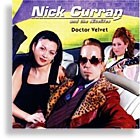

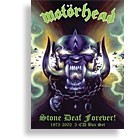
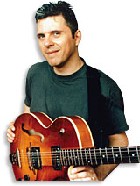
.jpg)
